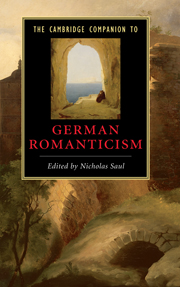Book contents
- Frontmatter
- 1 What is Romanticism, and where did it come from?
- 2 From early to late Romanticism
- 3 Prose fiction of the German Romantics
- 4 The Romantic lyric
- 5 The Romantic drama
- 6 Forms and objectives of Romantic criticism
- 7 Romanticism and Classicism
- 8 Women writers and Romanticism
- 9 The Romantics and other cultures
- 10 Love, death and Liebestod in German Romanticism
- 11 Romantic philosophy and religion
- 12 Romantic politics and society
- 13 Romantic science and psychology
- 14 German Romantic painters
- 15 Romanticism and music
- 16 Transformations of German Romanticism 1830-2000
- Key authors and their works
- Further reading
- Index
10 - Love, death and Liebestod in German Romanticism
Published online by Cambridge University Press: 28 September 2010
- Frontmatter
- 1 What is Romanticism, and where did it come from?
- 2 From early to late Romanticism
- 3 Prose fiction of the German Romantics
- 4 The Romantic lyric
- 5 The Romantic drama
- 6 Forms and objectives of Romantic criticism
- 7 Romanticism and Classicism
- 8 Women writers and Romanticism
- 9 The Romantics and other cultures
- 10 Love, death and Liebestod in German Romanticism
- 11 Romantic philosophy and religion
- 12 Romantic politics and society
- 13 Romantic science and psychology
- 14 German Romantic painters
- 15 Romanticism and music
- 16 Transformations of German Romanticism 1830-2000
- Key authors and their works
- Further reading
- Index
Summary
In this essay I shall argue something infrequently heard in modern academic discourse: that we need to turn the clock back a little in the scholarship of German Romanticism (if only to go forward the more progressively). It used to be commonplace to link German Romanticism intrinsically with a suspect ideology of love and death, and in especial with the erotic death cult most prominently exemplified by the Liebestod of Richard Wagner's doomed Tristan and Isolde. But scholarship in recent decades has turned away from that preoccupation. With some justification, it is true, other themes have come to the fore. Romanticism is (for example) now no longer thought of as an aggressively irrationalist and obscurantist phenomenon. Instead, its anti-Enlightenment polemic is understood as the expression of a pioneering critique of abstract rationalism very much within the utopian tradition of the project of Enlightenment. Similarly, the engagement of Romantic thinkers with the political sphere is now recognised to be much more complex than the received scheme of conservatism and reaction used to suggest. And analogous corrections of our historical understanding have been made across virtually the entire spectrum of Romanticism's thematic preoccupations. This is true in some sense of the traditional identification of Romanticism with morbidity and perverse love. Thomas Mann's early novella Tristan (1902) well represents what we used to think. This bleak allegorical analysis of the sickness afflicting art, life and modern culture certainly foregrounds and criticises a pessimistic ideology of love and death. In a sanatorium around 1900 the beautiful, yet mortally ill Gabriele Klöterjahn encounters a minor aestheticist poet, Detlef Spinell. In the absence of her merchant husband, they recognise an aestheticist affinity and fall in love.
- Type
- Chapter
- Information
- The Cambridge Companion to German Romanticism , pp. 163 - 174Publisher: Cambridge University PressPrint publication year: 2009
- 2
- Cited by



